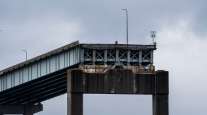Senior Reporter
FHWA Announces Proposal to Improve Bridge Inspection Program

[Stay on top of transportation news: Get TTNews in your inbox.]
The Federal Highway Administration has issued a proposed rule to improve oversight of U.S. bridge inspections by incorporating a risk-based approach and encouraging the use of such technological advancements as unmanned aerial systems and sonar.
The proposal seeks to comply with provisions contained in MAP-21. The 2012 transportation reauthorization law established new requirements for the National Bridge Inspection Standards program, maintaining a bridge inventory, and reporting to FHWA bridge inspection results — especially, critical findings of structural or safety-related deficiencies. It also would require the agency to address “ambiguities” identified since the last update to the program in 2009.
“Periodic and thorough inspections of our nation’s bridges are necessary to maintain safe bridge operation and prevent structural and functional failures,” said the proposal, posted in the Federal Register on Nov. 12. “In addition, data on the condition and operation of our nation’s bridges is necessary for bridge owners to make informed investment decisions as part of an asset management program for their bridges.”
The proposal applies to all highway bridges on all public roads, on and off federal-aid highways that include tribally and federally owned bridges and privately owned bridges that are connected to a public road on each end.
“In this day of significant technological advancements, other disruptive technologies will be developed that will change the way inspectors perform bridge inspection,” the proposal said. “Two recent examples of new technologies that FHWA is evaluating are sonar technologies for underwater bridge inspection and unmanned aerial systems.”
Bridge Notice, Federal Regi... by Transport Topics on Scribd
The agency also proposes to repeal two outdated regulations: The Highway Bridge Replacement and Rehabilitation Program and the Discretionary Bridge Candidate Rating Factor.
According to the most recent estimate by the American Road and Transportation Builders Association, 47,052 of America’s 616,087 bridges are “structurally deficient” and in poor condition, and 235,000, or 38%, need repair, replacement or major rehabilitation.
Some of the changes mentioned in the proposal have been implemented through policy, but an FHWA October assessment report in support of the proposed rule said it is needed to take full advantage of updates to “risk-based inspection intervals” that would give more flexibility to stakeholders.
“Without the law and these proposed rules there would be little motivation for such improvements to be implemented at a national level,” the assessment report said. “The absence of motivation stems from the fact that there is no private market for national bridge inspection data or standards. These standards are used by government agencies for managing bridges.”
The National Bridge Inspection Standards program has a history of using a one-size-fits-all approach by requiring routine inspection to typically occur every 24 months, nonredundant steel tension member inspections every 24 months and underwater inspections every 60 months, FHWA said.
“By using a risk-based process, FHWA proposes to allow those inspection intervals to potentially be extended up to 72 months, 48 months, and 72 months, respectively,” the assessment report said.
The assessment report also said that the proposal includes suggested procedures for inspection of bridges under construction or temporary bridges and thorough initial inspections to determine baseline conditions. In addition, it calls for the agency to include minimum time frames for bridges to have an analysis of their load capacity, time frames for installing load posting signs when a bridge cannot safely carry legal loads and for owners to establish thresholds for when a bridge must be closed.

Another requirement of the proposal would be aimed at creation of better-qualified inspection personnel and establishment of a national certification for bridge inspectors.
“This provides an opportunity for increasing the competency level of bridge-inspection personnel. The increased focus on training will ensure staff is better aware of critical areas to focus the inspection on so deficiencies can be properly identified and then addressed,” the assessment noted.
A 2018 report by ARTBA’s Bridge Policy & Promotion Council concluded that although the number of structurally deficient bridges is down compared with 2017, the pace of improvement has slowed compared with the prior five years.
“At this rate, it would take over 80 years to make the significant repairs needed on these structures,” the ARTBA report said.
Want more news? Listen to today's daily briefing:




